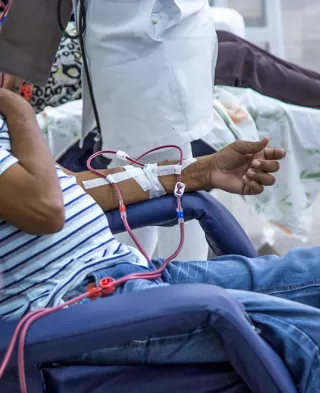
Diagnosis and Treatment Options
Diagnosis and Treatment Options
A diagnosis of chronic kidney disease can be scary and stressful. Educating yourself about treatment options and resources will empower you to shape your healthcare outcome.
Here are 3 important steps to managing life around CKD:
Dialysis Treatment Options
Understand each treatment option and how it might impact your lifestyle.
Kidney Transplantation
A kidney transplant is an operation that places a healthy kidney from another person into your body. The kidney may come from someone who has died or from a living donor.
Kidney Donation
There are 2 options for a kidney transplant: Deceased Donation and Living Donation
No Treatment as an Option
No treatment is an important option for some patients. You have the right not to start dialysis if you feel that the burdens outweigh the benefits.
Be Empowered
You have the power to help shape your outcome with kidney disease through awareness, education, and active participation in selecting your treatment options. Here are some strategies that will empower you:
Prepare questions ahead of time for appointments with your healthcare team. Make notes during appointments. Take a trusted caregiver or advocate with you.
Make a list of questions before each visit. Use the Kidney Health Checklist for a Healthcare Provider’s Visit as a resource. Ask others for their input. It’s hard to think of everything you need to ask when you’re under stress.
Work at communicating your questions, thoughts, and feelings to your healthcare team. Bring up the difficult questions that you would rather not talk about.
Take notes during appointments so that you can remember the discussion later.
Take a trusted caregiver or advocate with you. Talk about the appointment after it’s over. Update your notes with anything you’ve left out. Write down follow-up steps and any questions you have.
Be active in your own care.
Don’t expect your providers to make all the decisions for you. Learn about options. Make your wishes known.
Once you are referred for a kidney transplant evaluation, get all the testing done as quickly as possible. Stay in close contact with the transplant team.
If you are told that you don’t qualify for a transplant, ask why. Find out if you might be eligible at some future time. Go to a different transplant center. Sometimes selection criteria, such as body mass index (BMI), differ from center to center.
Make a plan. Focus on what needs to be done rather than on what may happen in the future.
Write out a plan of steps to take. Accept reality and focus on what needs to be done rather than on what may happen in the future. Don’t waste time wishing things were different. Direct your mental and physical energy towards accomplishing the goals you have defined in your plan.
Practice self-care.
Take care of yourself by eating a healthy diet as directed by your dietician. Get some type of exercise every day. Try to spend time outside or in nature. It is important to nurture your body and your mind.
Spend 10 minutes a day practicing mindfulness and meditation.
A mindfulness and mediation practice can help calm the mind and relieve stress. Try the free app Smiling Mind. Another popular meditation app is Headspace, which includes special meditations to help with sleep.
Write in a journal.
Writing in a journal helps process emotions and relieve stress. You can make lists, develop questions, draw pictures, or tell your story. A journal gives you a place to put your thoughts or worries on paper and unburden your mind.
Ask for support.
Ask for the support you need. Here are some no cost resources from the National Kidney Foundation (NKF) Get Support webpage:
Call 855.NKF.CARES (855.653.2273) or email [email protected]
Talk to someone who has experienced CKD; call 855.NKF.PEERS (855.653.7337)
Ask questions, get answers, and share experiences in these safe online communities: NKF Kidney Disease Community, NKF Dialysis Community, NKF Transplant Community, NKF Kidney Donor Community, NKF Parents of Children with Kidney Disease.


